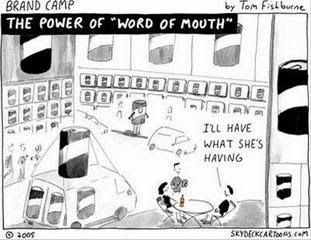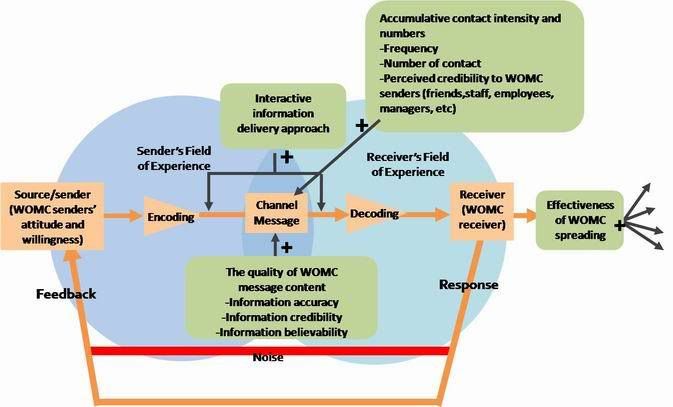By Takhta Pandu Padmanegara
Graduated from President University
Majoring in Public Relations
“WOMC is seven times more effective than newspapers and magazines, four times more effective than personal selling, and twice as effective as radio advertisements in influencing consumers to switch brands”
(Ennew, Banerjee & Li, 2000)
(Ennew, Banerjee & Li, 2000)
The Effectiveness of WOMC
Public Relations is defined as “the practiced in organizations that range from giant, multinational telecommunication companies to small human service agencies and fledging social movement organizations” (Lattimore, 2004, p.5). Public Relations is a leadership and management function that helps to accomplish “organizational objectives, define philosophy, and facilitate organizational change” (Lattimore, 2004, p.5).
Robert L. Heath (Encyclopedia of Public Relations, 2005) defined Public Relations as “a set of management, supervisory, and technical functions that foster an organization's ability to strategically listen to, appreciate, and respond to those persons whose mutually beneficial relationships with the organization are necessary if it is to achieve its missions and values.”
Therefore in every organization or institution Public Relations has important roles to gain positive image from its public and to maintain internal and external relationship. The essence of Public Relations, which are creating positive image from the public and maintaining relationship in order to achieve the organization goals, should be prioritized by the institution.
Public Relations practitioner has a lot of activities that related to promoting an entire organization. In research on PR activities two broad roles consistently emerge in public relations: the technician and the manager. The technician role represents the craft side of public relations: writing, editing, taking photos, handling communication production, running special events, and making telephone calls to the media. The manager role focuses on activities that help identify and solve public relations problems. The activities of Public Relations will affect the progress of the organization. Consequently, Public Relations is one of the key of successful tools in an organization, company, or institution. (Lattimore, 2004, p.6)
Public Relations also has roles to collaborate with marketing to promote the product or service. There are many ways for Public Relations officer can do in promoting the products or services and building its image for the organization or company. They can use the promotional tools; such as brochure, banner, poster, flyer, etc; using advertisement through media, doing direct and indirect sales marketing strategy, and also establishing an event to increase the awareness of the product/services. All of integrated activities between public relations and marketing could be defined as Integrated Marketing Communication (IMC). (Belch and Belch, 2004)
Although Public Relations and Marketing officers already maximized the promotion using many promotional tools, it could not be effective if they do not deliver the message clearly and suitable to the products or services that are offered. That is why in IMC there is one promotional tool that many Public Relations and Marketing officers forget, it is Word-of-mouth Communication (WOMC). As Walter J. Carl (2005), said that peer-to-peer conversations and recommendations are among the most trusted forms of communication. WOMC has strong influential power in leading and guiding messages received when searching for information, allocating searching efforts, and undertaking the decision process (Thakor & Kumar on Carl, 2005).

WOMC can be encouraged and facilitated. Companies can work hard to make people happier, they can listen to consumers, they can make it easier for them to tell their friends, and they can make certain that influential individuals know about the good qualities of a product or service (WOMC 101, a WOMMA white paper, 2006). Word-of-mouth communication (WOMC) is one of most influential decision making factors in the service purchase decision and yet it remains beyond the control of marketers both for individuals and organizations (Swan & Oliver; Wee, Lim & Lwin on Carl, 2005).
Types of WOMC
There are two types of WOMC which are Organic WOMC and Amplified WOMC (Carl, 2005). Organic or Natural WOMC occurs naturally when people become advocates because they are happy with a product and have a natural desire to share their support and enthusiasm. Practices that enhance organic WOMC activity include, focusing on customer satisfaction; improving product quality and usability; responding to customer concerns and criticism; opening a dialog and listening to people; and earning customer loyalty.
Amplified WOMC occurs when marketers launch campaigns designed to encourage or accelerate WOM in existing or new communities. Practices that amplify WOMC activity include creating communities; developing tools that enable people to share their opinions; motivating advocates and evangelists to actively promote a product; providing advocates information that they can share; using advertising or publicity designed to create buzz or start a conversation; identifying and reaching out to influential individuals and communities; researching and tracking online conversations. (Carl, 2005)
Organic WOMC is arguee to be more effective because it is a reflection of customer satisfaction and it is an ethical PR practice (Carl, 2005). While amplified WOMC can be potentially unethical if the procedure or act that is used by which corporations seek to influence buying decisions is not a proper way. For instance to create the impression that a person is an actual consumer describing one's experience with a product when the person is not an actual consumer (e.g., a paid third-party posting information on blogs or message boards, the message that is delivered is not the truth or real information, and so on).

WOMC can greatly affect the impact of message. Whatever it is called, WOMC is cheap because it does not rely on expensive media buys. It can, however, be reinforced by media stories, which is where public relations come in (Holmes, 2000). WOMC is a powerful tool because of its high level of credibility. And, if the topic is hot, it can spread like wildfire (Belch and Belch, 2004).
How does WOMC works?
The Basic Model of Communication by Belch and Belch in Advertising and Promotion: An Integrated Marketing Communications Perspective, 2004
The major theoretical model that has been chosen is the Basic Model of Communication, which is shown in Figure under (Belch and Belch, 2004, p.139). This model is the most appropriate due to the fact that WOMC fit under its scope.

The Basic Model of Communication
This model provides the basic model of communication where the source or sender encodes the information or message based on sender’s field of experience. Then message is sent through channel. After that, the message will be decoded by receiver based on receiver’s field of experience. The communication process after the receiver received and understood the message, he or she wills response and giving feedback to the source. At any process of communication noise would become the barrier and distort the process (Belch and Belch, 2004).
In order for the communication process to be effective, “the message decoding process of the receiver must match the encoding of the sender” (Belch and Belch, 2004, p.141).
The basic model describes all forms of communication – including traditional advertising and consumer-controlled advertising, which is WOMC. However, it is the differences between these two forms of promotion which are essential to the success of each. In terms of the basic communications model, there are certain areas of the actual process which are applicable to both WOMC and traditional advertising. These applicable pieces of the promotion process are the sender, the message, the channel, and the receiver. In addition, noise and fields of experience also influence the process.
WOMC Implication in Communication Model

The communication process for WOMC is fundamentally different from traditional advertising. The most basic difference is in the sender. In the case of WOMC, the information begins with the agent of WOMC, who is the original sender.
A message is encoded and then sent into channels for exposure to the recipients. However, once the recipients receive the message, the marketer is eliminated from the communications process. The receiver becomes the sender and diffuses information to many other consumers. The three key characteristics of the sender (credibility, attractiveness, and power) still apply, however they are applicable to the consumers as they send and receive the information amongst themselves. The most important part of the WOMC model is the sender. The message is delivered to the receiver by a friend or trusted source. (Belch and Belch, 2004, p.143)
In the traditional advertising model, the marketer maintains control of the message at all times. This results in a consistent advertisement that is delivered to all consumers, no matter if they are or are not paying attention. However, in the WOMC (Amplified WOMC) approach, the agent of WOMC has control over the first diffusion of the message. (Belch and Belch, 2004, p.141-142)
Instead, conversations form the channel in which the information is transmitted. The conversations are classified as personal channels, meaning that the receiver knows the person who is sending him the information (Belch and Belch, 2004, p.143). This distinct channel is the dominant difference between WOMC and other forms of promotion or advertising. Because the channel is a conversation between two people, the brand advocation has no limits. Also, it breaks through the clutter more effectively because it is more difficult to ignore a brand advocation from someone with whom you are speaking.
A sender can utilize a conversation (in the offline or online world) to send product information to a receiver. Upon decoding the information, the receiver can then become a sender and open another channel of communication with a new receiver.
Usually in buzz marketing (WOMC) the receiver’s field of experience directly overlaps with the sender’s field of experience. This makes the problem of noise less applicable because it is easier for the receiver to pay attention to the sender’s message. However, there are significantly more elements in the receiver’s environment which can influence his interpretation of the message. In the case of word of mouth communications, a receiver can be influenced by the body language of the person with whom he is conversing. “This is not likely to occur in traditional mass-media advertising.” (Belch and Belch, 2004, p.95)
Word of Mouth Communication Model Theory by Chen (2006)

The conceptual model of effectiveness of WOMC spreading in educational services
(The model was developed in WOMC research for Asian international students searching for Australian higher education services)
(The model was developed in WOMC research for Asian international students searching for Australian higher education services)
The WOMC spreading effectiveness model explained the factors that could establish the positive WOMC spread effectively in educational services. The factors which are WOMC senders’ attitude and willingness, interactive information delivery approach, the quality of WOMC message content, and accumulative contact intensity and numbers would lead to positive WOMC spreading effectively (Chen, 2006,).
Explanation
The effectiveness of WOMC depends on four factors, there are:
1. WOMC senders’ open, honest attitude and willingness
WOMC senders’ open, honest attitude and willingness seem to build up the credibility and trust in WOMC receivers. Chen (2006) explained that “the open attitudes and willingness of WOMC senders were the key elements to build up the foundation of creditability, believability, and mutually trusting feeling in the interactive communication process.”
Therefore WOMC receivers preferred or expected WOMC senders to deliver messages with a neutral position. It was expected that WOMC senders had no intention to influence and that they would provide positive emotion support. (Chen, 2006)
2. Interactive information delivery approach
“WOMC receivers prefer the interactive information delivery approach through comprehensive impersonal and WOMC information content together.” (Chen, 2006)
In her study, Chan (2006) explored that participants preferred to see the information that was interesting and presented in an interactive demonstration. In other words, “WOMC receivers found it easy to learn from the information presented in the face-to-face, oral and casual conversational model rather than through virtual communication.” and “participants appreciated the information content that included personal sources and impersonal sources by the third party together either in WOMC messages or university publications.”
3. The quality of WOMC message content
High-quality content of WOMC messages was one of the crucial reasons for prospective students to revisit WOMC sources repeatedly and to follow the instruction
For participants, excellent information content should include three aspects: information accuracy, credibility, and believability. (Chen, 2006). The higher WOMC message content quality “(information accuracy, credibility, believability)” leads to the higher possibility to attract prospective students.
In addition, Chen (2006) argued that the strength of social tie may not influence WOMC receivers consistently throughout the entire information gathering process. Although the strong social-tie WOMC resources were strongly related to the credibility of information sources, the relationship to WOMC receivers did not seem to be consistently reflected throughout the entire information gathering process (Chen, 2006, p.183)
4. Accumulative contact intensity and numbers
“Number of contact with WOMC message providers accumulates the strength of relationship (Chen, 2006, p.183).” Whenever participants faced potential concerns or practical issues that needed to be solved, participants often tended to enquire through face-to-face communication with WOMC senders.
Frequency and number of contact would perceive credibility to the WOMC senders. “Friends are the most influential WOMC senders” but sometimes family also could become the strongest one in decision making (Chen, 2006, p.183).
My Constructed Model for WOMC
Researcher’s Constructed Model by Integrating Belch and Belch’s Basic Model of Communication and Chen’s Word of Mouth Communication Model Theory
Based on the models, the researcher constructed the new model by integrating both models; the effective WOMC is shown more precisely in the model as follow:
The integrated model of Belch and Belch’s Basic Model of Communication and Chen’s Word of Mouth Communication Model Theory
The concept shows that the WOMC source sends the message based on attitude and willingness to share and to tell the information through channel with the information delivery approach to the WOMC receiver. The WOMC receiver will influence and accept the message when the WOMC message content has accuracy, credibility, and believability. The message represents the first of two locations where the sender’s field of experience overlaps with the receiver’s field of experience.
The process of accepting the WOMC message is also influenced by the accumulative contact intensity and numbers of both parties in order to establish credibility. When the receiver accepts the WOMC message, he or she will give the response as a feedback to the sender and spread the WOMC to the other.
WOMC has important role for marketers in promoting a new product or service. The role was explained by Gilly, Graham, Wolfinbarger, and Yale (1998) in Academy of Marketing Science Journal, A dyadic study of interpersonal information search, below those personal sources take part in WOMC.
“Marketing researchers have found that personal sources play a particularly influential role in affecting product choice, selection of service providers, and in the diffusion of information regarding new products. Personal sources often are rated by consumers as the most important source of information, especially when the information seekers perceive high risk, or when consumers are generally susceptible to interpersonal influence” (Gilly, Graham, and Wolfinbarger., 1998, p. 83).
Therefore WOM (Word of Mouth) communications have been studied as both an input into consumer decision-making and an outcome of the purchasing process. One of the most widely accepted notions in consumer behavior is that word-of-mouth communication plays an important role in shaping consumers’ attitudes and behaviors (Brown and Reingen, 1987).
The unique influential factors of WOMC
There are four unique influential factors that would stimulate consumers to initiate WOMC. “These factors include incentives, social ties, cultural influences, and customer satisfaction” (Chen, 2006, p.41).
1. Incentives
Arndt and Writz on Chen (2006) point out that incentive or motivation “is an effective marketing promotion tool to manage WOMC behavior.”
On the other hand, the marketer should increase the level of consumers’ incentives in order to gain a positive purchase recommendation to influence prospective customers.
2. Social ties
Social ties have a strong impact on the credibility of WOMC They can have a stronger promotional effect than advertising in information spreading (Goldenberg on Chen, 2006, p.42). The effect of social ties in WOMC activities comes from the factor of social affiliation in which people have “a tendency to affiliate with others and to engage in social relationship” reference:
“The strength of social ties is likely to favor WOMC activities. People with strong social ties simply know best about WOMC receivers. WOMC messages are more likely to be strong with peer and families, who have strong social ties. Their WOMC approach is more direct and honest and follows the satisfaction level of the consumer more closely, especially when consumers experience dissatisfaction about service quality.” (Chen, 2006, p.42)
Therefore, when consumers receive WOMC messages from strong social-tie WOMC senders, WOMC messages directly influence consumers’ purchase decisions.
3. Cultural influence
Consumers’ cultural orientation affects WOMC activities. The study by Liu, Furrer and Sudharshan (2001) indicates that “the consumer cultural background affects service quality expectations, the shaping of personal perception, and WOMC initiation intentions, especially among customers who come from low individualism cultural backgrounds or those with higher level of uncertainty avoidance.”(Chen, 2006, p.44)
In conclusion, if the institution wants to gain positive WOMC, the institution should increase its service quality. Because when customers have a strong background understanding of the area and a low level of individualistic orientation or higher level of risk uncertainty avoidance, they tend to initiate positive WOMC if they have experienced excellent service quality. These customers also “have lower intention to complain and to switch service providers even though they have experienced poor service quality.” (Chen, 2006, p.44)
4. Customer satisfaction
“Service satisfaction is the main resource or top determination source for consumers and service providers to generate positive WOMC in the post-consumption phase. Scholars indicate the higher level of customer satisfaction leads to higher purchase intentions and positive WOMC.” (Feick & Higie,; File,; Wirtz & Chew on Chen, 2006, p.45)
Based on explanation above, we could know that when service quality does not meet customers’ perceived standard, consumers are likely to initiate negative WOMC activities to directly contact numbers of prospective customers.
Moreover, the key influential parties to be included as a part of the marketing target audience (WOMC sender) in WOMC promotion are who are frequently close to consumers (Lau & Ng on Chen, 2006, p.45).
Previous consumer experience and expectation as well influences the levels of service satisfaction. Burton on Chen (2006) concludes that “experienced customers tend to have higher satisfaction standards to measure service providers’ performance.” If the expectations of service quality are met with experienced customers, they would tend to be more satisfied than novice customers. Moreover, for experienced customers, a small positive improvement in service quality may not result in any improvement of satisfaction.
In conclusion, experienced customers look for higher overall satisfaction than their higher expectations. If service performance is less than their expectation, the level of satisfaction would drop easily. But on the other way around, the new or novice customers it is easier to satisfy their standard with a small amount of service quality that only has small improvement beyond their expectations. (Chen, 2006, p.44)











Tidak ada komentar:
Posting Komentar